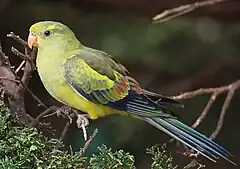| Polytelis[1] | |||
| Wagler, 1832[2] | |||
 Przedstawiciel rodzaju – księżniczka słoneczna (P. anthopeplus) | |||
| Systematyka | |||
| Domena | |||
|---|---|---|---|
| Królestwo | |||
| Typ | |||
| Gromada | |||
| Podgromada | |||
| Infragromada | |||
| Rząd | |||
| Rodzina | |||
| Podrodzina | |||
| Plemię | |||
| Rodzaj |
Polytelis | ||
| Typ nomenklatoryczny | |||
|
Psittacus barrabandii Swainson, 1821 (= Psittacus swainsonii Desmarest, 1826) | |||
| Synonimy | |||
|
| |||
| Gatunki | |||
| |||
Polytelis – rodzaj ptaków z podrodziny papug wschodnich (Psittaculinae) w rodzinie papug wschodnich (Psittaculidae).
Zasięg występowania
Morfologia
Długość ciała 40–45 cm; masa ciała 114–157 g[8].
Systematyka
Etymologia
- Polytelis (Polyteles): gr. πολυτελης polutelēs „znakomity”, od πολυς polus „więcej”; τελος telos „koszt, uroczystość”[9].
- Barrabandius: epitet gatunkowy Psittacus barrabandi Swainson, 1821; Jacques Barraband (lub Barraban) (1767–1809), francuski projektant, artysta, malarz ptaków[9]. Gatunek typowy: Psittacus barrabandii Swainson, 1821 (= Psittacus swainsonii Desmarest, 1826).
- Spathopterus: gr. σπαθη spathē „szpachla”; -πτερος -pteros „-skrzydły”, od πτερον pteron „skrzydło”[9]. Gatunek typowy: Polytelis alexandrae Gould, 1863
- Northipsitta: Alfred John North (1855–1917), australijski jubiler, owolog; nowołac. psitta „papuga”, od gr. ψιττακη psittakē „papuga”[9]. Nazwa zastępcza dla Spathopterus North, 1895 ponieważ Mathews uważał, że nazwa ta jest zajęta przez Spathoptera Audinet-Serville, 1835 (Coleoptera).
- Sindelia: Stanley Raymond Sindel (ur. 1935), australijski awikulturolog[9]. Gatunek typowy: Palaeornis anthopeplus Lear, 1831.
Podział systematyczny
Do rodzaju należą następujące gatunki[10]:
- Polytelis alexandrae Gould, 1863 – księżniczka wspaniała
- Polytelis anthopeplus (Lear, 1831) – księżniczka słoneczna
- Polytelis swainsonii (Desmarest, 1826) – księżniczka tarczowa
Uwagi
- ↑ Niepoprawna późniejsza pisownia Polytelis Wagler, 1832.
Przypisy
- ↑ Polytelis, [w:] Integrated Taxonomic Information System (ang.).
- ↑ J.G. Wagler. Monographia Psittacorum. „Abhandlungen der Mathematisch-Physicalischen Klasse der Königlich Bayerischen Akademie der Wissenschaften”. 1, s. 489, 1832. (niem.).
- ↑ Ch.L. Bonaparte: Conspectus generum avium. T. 1. Lugduni Batavorum: Apud E.J. Brill, 1850, s. 2. (łac.).
- ↑ H.G.L. Reichenbach: Avium systema naturale. Das natürliche system der vögel mit hundert tafeln grösstentheils original-abbildungen der bis jetzt entdecken fast zwölfhundert typischen formen. Vorlaüfer einer iconographie der arten der vögel aller welttheile. Dresden und Leipzig: Expedition der vollständigsten naturgeschichte, 1850, s. ryc. lxxxii. (niem.).
- ↑ A.J. North. Preliminary descriptions of a new genus and of five new species of Central Australian birds. „The Ibis”. Seventh series. 1, s. 339, 1895. (ang.).
- ↑ G.M. Mathews. Substiute-names. „Austral Avian Record”. 1, s. 127, 1912–1913. (ang.).
- ↑ R. Wells & R. Wellington. A classification of the cockatoos and parrots (Aves: Psittaciformes) of Australia. „Sydney Basin Naturalists”. 1, s. 118, 1992. (ang.).
- 1 2 S.M. Billerman: Old World Parrots (Psittaculidae), version 1.0. W: S.M. Billerman, B.K. Keeney, P.G. Rodewald & T.S. Schulenberg (red.): Birds of the World. Ithaca, NY: Cornell Lab of Ornithology, 2020. DOI: 10.2173/bow.psitta4.01. [dostęp 2020-10-20]. (ang.).

- 1 2 3 4 5 Etymologia za: The Key to Scientific Names, J.A. Jobling (red.), [w:] Birds of the World, S.M. Billerman et al. (red.), Cornell Lab of Ornithology, Ithaca (ang.).
- ↑ Systematyka i nazwy polskie za: P. Mielczarek & M. Kuziemko: Plemię: Psittaculini Vigors, 1825 (Wersja: 2022-09-13). [w:] Kompletna lista ptaków świata [on-line]. Instytut Nauk o Środowisku Uniwersytetu Jagiellońskiego. [dostęp 2022-10-11].
This article is issued from Wikipedia. The text is licensed under Creative Commons - Attribution - Sharealike. Additional terms may apply for the media files.